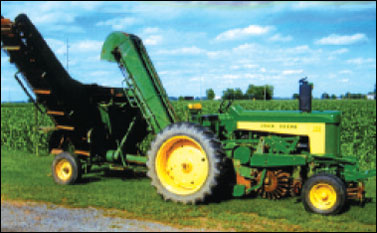
would sleep a couple of hours on a floor register to
warm his bones and soothe his weary back. He
would always have a smile on his face, but you
could see the worry in his eyes. He was always concerned
about getting everyone’s beets out on time
before the northern winter closed in.
Unfortunately, not all stories have a happy ending.
In 1978, the Buckeye Sugar Co. went bankrupt and,
after years in bankruptcy court, farmers were only
paid pennies on the dollar for their hard work. It
just goes to prove that the glory days are not always
the easiest of times; instead they were filled with
hard work shared by men of integrity striving
toward a common goal. After the sugar plant closed,
the equipment was parked out back to rust in peace.
After years of false rumors of another sugar plant
opening, almost all the equipment was sold for
scrap. Our No. 100, however, after years of service,
was parked in the corner of the machine shed. Over
30 years later, listening to one of those glory day
conversations, I mentioned that Lawrence still had a
complete 100 in the shed. The Maassel brothers,
who were nephews to one of the gentlemen whom
my father had harvested for, overheard the conversation.
Their eyes lit up…
The Maassel’s are avid collectors and restorers of
John Deere equipment. They came up with the idea
of hooking the 100 to their “730” and taking it to
the Henry County Fair. You should have seen the
heads turn when they pulled in with their very nice
“730”, with a little bit of history tagging along
behind it.
Larry A. Gerken
My brothers and I discovered that Lawrence
Gerken had a No. 100 Beet Harvester, and that it
had been used with a “730” Diesel tractor. We
looked for a “730” like that, but could only find
them with tricycle front ends. |
One day at the coffee shop, I talked to a friend
who had two “730s” and wanted to get rid of one of
them. It had a tricycle front, so we went looking for
an adjustable wide front axle. We found one, badly
rusted. It took two 30-ton jacks to get it apart. We
cleaned it up, reassembled it, and went to get
Lawrence’s beet harvester.
All the parts needed were loaded up, the beet cart
was hooked on, and we headed back to our barn.
All the chains on the cleaning bed had to be cut
off and replaced. With a little work, all the cleaning
bed rollers were moving again. After cleaning and
repairing some of the other parts, the No. 100 was
able to be mounted on the tractor. We hooked up
the beet cart and wired its electric clutch. Everything
worked.
We took the outfit to the National Thrasher’s
Association Convention at the Fulton County (Ohio)
Fairgrounds in June 2010. We also showed at the
Antique Tractor Show at the Henry County Fair,
where it won the award for “Most Unusual Exhibit.”
Loren Maassel, Ohio

In “Matched Working Equipment — Part VII,” a
No. 2 Swath Fluffer was shown (September–October
2011, page 23). The text said that it was introduced
in 1959, but what was the last year the No. 2
was offered and what was the list price?
C.H., New Mexico
We don’t have implement price lists that date that late,
but perhaps a reader does. Further, we don’t have information
that leads us to the end of production. The only way we
knew that the No. 2 began in 1959 was because of the introductory
literature with that date. If readers can help, we
encourage you to write. As a dynamic, smooth-functioning
organization — with input from a broad base of members
— everyone benefits.

I have noticed that you sometimes put the name
of the person (writing a letter), sometimes you
leave off the last name, and sometimes you say
“name withheld.” Why is that?
Kevin M., Iowa |





